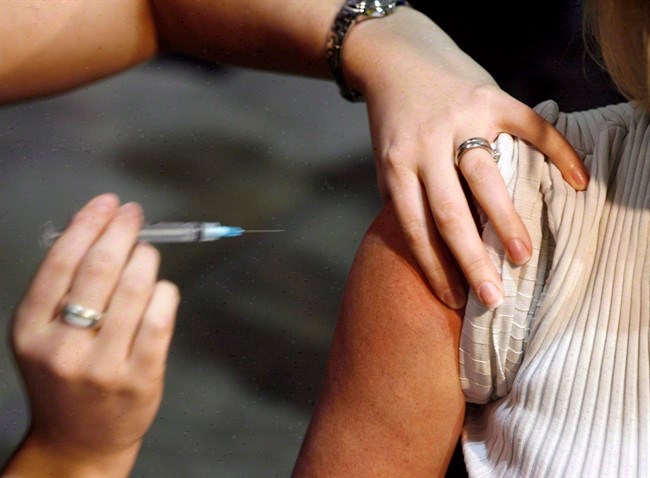TORONTO - Making a vaccine to protect against the new H7N9 flu virus that has emerged in eastern China could prove to be problematic, influenza experts acknowledged Thursday.
There hasn't been enough time to produce even the seed strain to make H7N9 vaccine, let alone small batches of a prototype vaccine for testing. So researchers haven't had a chance to see how a vaccine against this new flu strain might work in people.
But clinical trials of vaccines made to protect against other viruses in the H7 family have shown the vaccines don't induce much of an immune response, even when people are given what would be considered very large doses.
"In all cases where these vaccines were trialed, it was found that the vaccines were poorly immunogenic," said Nancy Cox, the virologist who heads the influenza branch at the U.S. Centers for Diseases Control in Atlanta.
"And so this is a signal that we might be facing challenges with producing an immunogenic vaccine using this particular virus. But that remains to be determined."
Cox and CDC flu expert Dr. Tim Uyeki touched on the potential problem in a perspective article on the H7N9 situation published online Thursday by the New England Journal of Medicine.
The perspective accompanied an article by Chinese clinicians describing the first three H7N9 infections that came to light in their country. The article outlines how sick the patients became — in a word, very — and what the genetic sequences of the viruses recovered from them indicate about the path H7N9 took through nature to get to people.
Chinese authorities are still trying to determine how many species carry the virus in China and how people are coming in contact with it. As such, many questions remain about how this virus erupted in such an explosive manner. In less than two weeks since it was first reported, there have been 38 confirmed cases and 10 deaths due to H7N9 in China. The available genetic evidence suggests several flu viruses from wild birds swapped genes to come together in this particular viral constellation.
As for the symptoms the illness caused, they included encephalopathy (inflammation of the brain), septic shock, acute respiratory distress syndrome and rhabdomyolysis, which is a breakdown of muscle tissue.
"Some of them had multi-organ failure," said Uyeki. "This is very, very severe disease, and rapidly progressive. And it's similar to H5N1 (bird flu), but it's a little hard to make comparisons based upon three cases and limited data."
Among the concerning issues about this virus is the question of how a vaccine might work, if one is needed.
A standard dose of flu vaccine is 15 micrograms (mcg). Seasonal flu shots, most of which protect against three strains of flu at once, contain 45 mcg — 15 mcg per strain.
It is generally felt that with a new virus, people would need two shots apiece, given a couple of weeks apart. That's because the immune system needs to be first introduced to a virus (primed) and then given a second exposure, which boosts the antibodies to protective levels. So in a best case scenario, each person would need twice as much vaccine to protect against a new virus as he or she would get to protect against a seasonal flu strain.
But studies with previous H7 vaccines have shown poor responses in healthy adults who get a total of 180 micrograms of vaccine divided into two 90 microgram doses, said Michael Osterholm, director of the Center for Infectious Diseases Research and Policy at the University of Minnesota.
That means that even with 12 times the dose people get for seasonal flu, healthy adults don't get a great response to the vaccine. And given that the immune system wanes later in life, one would assume the challenge would be uphill from there.
"If we can't get a good response there" — with healthy adults — "the question is: Why would you ever expect a better response in the older population," noted Osterholm, whose team produced a major report on flu vaccine last year, called the CIDRAP Comprehensive Influenza Vaccine Initiative.
A per person dose of 180 mcg would sharply reduce the amount of vaccine available during a pandemic.
The latest global production estimate is 1.4 billion trivalent (three-in-one) shots in a year, Osterholm said, or 4.2 billion 15 mcg doses. Dividing that by 12 would suggest something in the order of 350 million people could be vaccinated in the first year of a pandemic — if all went well with production. Making flu vaccine is a finicky business and hitches in production are not uncommon.
A number of the vaccine manufacturers have products called adjuvants that can boost the impact of flu vaccine, allowing less vaccine to be used for each person. Adjuvants can stretch supplies significantly. During the 2009 H1N1 pandemic, sa���ʴ�ý and a number of European countries bought vaccine that included an adjuvant. The United States did not.
Since that pandemic, studies in several European countries have linked use of GlaxoSmithKline's adjuvant, AS03, with an increase in the incidence of narcolepsy among young people. (A study looking to see if rates also rose in sa���ʴ�ý is still underway.) Given the questions swirling around that situation, some countries may not feel safe to use an adjuvant with an H7N9 vaccine, Osterholm noted.
"If you add all those together, it doesn't paint a really very optimistic picture about influenza vaccine being a really significant weapon against this, should a pandemic emerge quickly," he said.
Countries with standing pandemic flu vaccine contracts are holding off on making a decision about whether to order H7N9 vaccine, watching how the outbreak unfolds. Meanwhile, vaccine manufacturing facilities are still tied up with the production of regular vaccine for the 2013-2014 Northern Hemisphere flu season.

